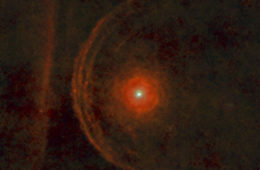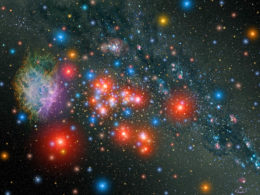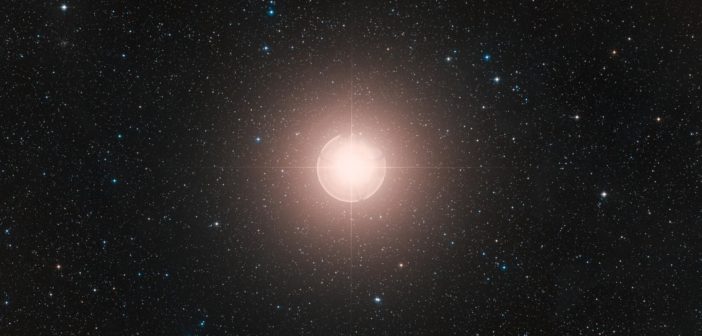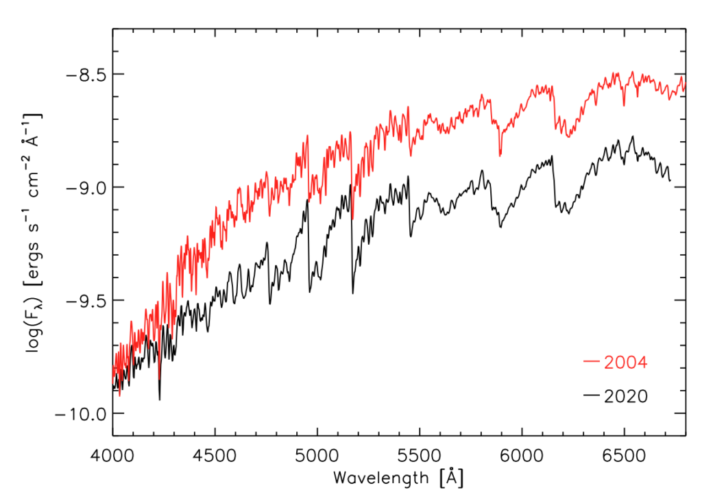Editor’s note: Astrobites is a graduate-student-run organization that digests astrophysical literature for undergraduate students. As part of the partnership between the AAS and astrobites, we occasionally repost astrobites content here at AAS Nova. We hope you enjoy this post from astrobites; the original can be viewed at astrobites.org.
Title: Betelgeuse Just Isn’t That Cool: Effective Temperature Alone Cannot Explain the Recent Dimming of Betelgeuse
Authors: Emily M. Levesque and Philip Massey
First Author’s Institution: University of Washington, Seattle
Status: Accepted to ApJL

Betelgeuse, shown here in an infrared image from the Herschel Space Observatory, is a luminous red supergiant star located only 650 light-years away from the Sun. [ESA/Herschel/PACS/L. Decin et al.]
The brightness of a star is often measured in specific wavelength bands because starlight is not monochromatic. The V band is defined at a wavelength of ~ 550 nm, which closely corresponds to wavelengths seen by the human eye.
On December 7th 2019, a team of astronomers observed that Betelgeuse had a brightness of V = 1.12 magnitude, compared to its typical value of V ~ 0.2–0.3 magnitude. This registered its faintest value in 50+ years (for historical reasons, magnitude increases as brightness decreases). Over time, the decrease in brightness continued, reaching its lowest value so far on January 30th (V = 1.61 magnitude). Around this time, it was also suggested that Betelgeuse’s dimming was slowing down.
Starry Eyed or Starry Died?
Many in the scientific community and general public have interpreted Betelgeuse’s erratic behaviour as an indication of an imminent supernova, which would be visible with the naked eye and likely to last for many days. While this is an exciting interpretation, it is also the least likely explanation. It is instead argued by many that the dimming could be due to the composition of Betelgeuse itself. Specifically, variations on the surface of Betelgeuse could lower its apparent temperature temporarily, which, according to laws of blackbody emission, would push some of its emitted light into longer wavelengths that wouldn’t be observed in the V band.
Keep Your Cool
The authors of today’s paper investigate how cool Betelgeuse actually is, and whether it is enough to explain its dimming in the night sky. They start by performing optical spectrophotometry on the RSG on February 15th 2020 using the spectrograph on the 4.3-meter Lowell Discovery Telescope in Arizona. The term “spectrophotometry” simply means measuring the spectrum of the star, where its flux is scaled according to its wavelength.

Artist’s illustration of one of the most massive star clusters within the Milky Way. The center of the cluster contains 14 red supergiant stars. [NASA, ESA and A. Schaller (for STScI)]
They compare the February 2020 Betelgeuse spectrum to a previous observation taken in March 2004. During this time, Betelgeuse had V ~ 0.5 magnitude, roughly 1.1 magnitude brighter than its brightness on 2020 Feb 15. Its corresponding apparent temperature was 3,650 K in 2004, compared with 3,600 K in 2020. The authors note that while the apparent magnitude (or flux) in 2020 is considerably lower than 2004, the overall shape of the spectrum is similar (Figure 1). The appearance of stronger TiO bands correlates with a lower apparent temperature. They go on to compare the temperature of Betelgeuse with other known RSGs in their sample, concluding that Betelgeuse is slightly cooler in 2020 compared to 2004. It is important to note that these measured temperatures each have a margin of error of ~25 K, which can exaggerate or diminish the actual temperature difference considerably.
The authors find that the temperature of Betelgeuse has not decreased proportionally to its dimming. If surface convection effects were responsible, a difference of larger than 50 K would be expected. This means a temporary “cold” period on the surface of Betelgeuse is likely not the primary cause of Betelgeuse’s loss of brightness, and some other effect must be at play.
Dust in Time
The authors also measure the amount of dust content along the line of sight to Betelgeuse, as this poses another possible explanation for its dimming. Circumstellar dust created from mass loss in Betelgeuse could potentially cause it to obscure its own light and therefore appear fainter. They find that there is no apparent change in the amount of dust between 2004 and 2020, but they nevertheless acknowledge that this conclusion assumes a particular model for dust absorption.
Observations have instead demonstrated that dust produced by RSG mass loss has a much larger grain size than expected by the typical dust model. Circumstellar dust composed of larger grains would produce an extinction effect that is more “grey”, absorbing light across the optical spectrum rather than preferentially absorbing bluer wavelengths. This large-grain dust could therefore cause dimming consistent with the change in V-band magnitude of Betelgeuse.
As of February 22nd, it was noted in this Astronomer’s Telegram that Betelgeuse has officially stopped dimming and has, in fact, begun to gradually brighten again. Various multi-wavelength observations, particularly in the ultraviolet and infrared range, are needed to shed some light on the stellar processes taking place in Betelgeuse which might be responsible for this exciting period of activity, while astronomers will keep their eyes peeled for any future episodes like this. Even though Betelgeuse might not be in the spotlight anymore, I will go on the record to say I always thought it was cool.
About the author, Sunayana Bhargava:
I’m a 3rd year PhD student at the University of Sussex, looking at X-ray observations of galaxy clusters to learn more about dark matter and large-scale structure.


